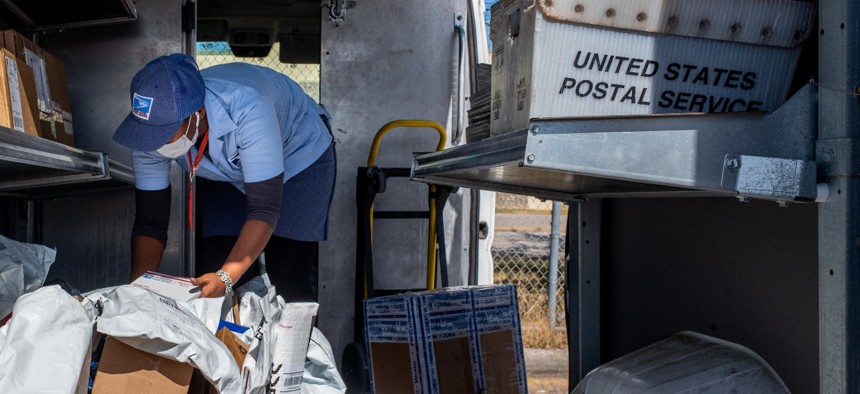Despite a Warning From Its Regulator, USPS Will Slow Down Some Package Delivery Starting in May
The Postal Service is implementing the next step of Louis DeJoy's plan.
The U.S. Postal Service is moving forward with its plan to slow down delivery for about one-third of small and lightweight packages as it advances its plan to cut costs and reverse longstanding financial losses at the agency.
Currently, USPS aims to deliver all First-Class packages in two or three days. Beginning May 1, that will shift to just 68%, with 17% taking four days and 15% taking five days. The change is part of Postmaster General Louis DeJoy’s 10-year strategy to steady postal finances and follows USPS slowing down its delivery standards for about 40% of First-Class mail last year.
The Postal Service is moving forward with the change despite USPS’ regulator in September blasting the agency for failing to demonstrate it could implement its operational plan, provide consistent and reliable service or achieve its anticipated efficiencies. Postal management leaned on oversimplified assumptions and predicted outcomes “potentially inaccurate and unachievable,” the Postal Regulatory Commission said. It added USPS failed to analyze the impact of its changes on customers and challenged the proportion of packages that would be affected.
While appearing reasonable, “the reasonableness of the proposal rests upon the Postal Service being correct in its assessments about consumer preferences and its ability to achieve the modeled increases in reliability, cost savings, and efficiency,” the commission wrote. “Should the Postal Service prove wrong in its predictions in the above areas, the rational basis for the proposal may prove illusory.”
The PRC opinion was advisory in nature and carried no enforcement mechanism.
USPS said its current standard of delivering about 80% of its First-Class packages in three days is unrealistic and no longer attainable. Postal management will reduce its reliance on air transportation and instead ensure its trucks are more full each time they go out, which it said will boost reliability. It has estimated $42 million in annual savings from the changes, but PRC questioned that total and said even if it were true it would have little bearing on the agency's overall finances.
The Postal Service maintained the slowdowns will improve reliability for customers while making its network more efficient. USPS will actually increase the rate of packages delivered within two days by 4%.
“This action will contribute to our cost savings efforts and improve our reliability across all product classes, including our growing package market,” DeJoy said. “By implementing the elements of our 10-year plan, we will deliver the consistent, reliable service that the American people and our customers expect and deserve and grow package volume, spurring revenue growth that can be invested back into the Postal Service.”
In a recent interview, DeJoy said he does not anticipate further changes to delivery standards after slowing down both mail and packages. He also predicted that ultimately “nobody’s gonna miss” the previous faster delivery times. He said he cannot compete with digital communication and will not try to do so, and offered advice to anyone looking for faster correspondence: “Email, if you need it there in a minute.”
DeJoy’s critics have noted that packages, such as pharmaceuticals, cannot be emailed. USPS has estimated that nearly all medicines currently delivered in two days would be unaffected, and 16% of those sent in three days would shift to a four or five-day window. Nearly 14% of medicines sent through USPS would be upgraded to faster delivery. PRC faulted postal management for failing to explore the impact of those changes on recipients of the pharmaceuticals and said “it may be wise” to exclude them from the slowdowns.
Postal customers will still offer a more expensive option, Priority Mail Express or regular Priority Mail, to ship packages anywhere within the contiguous United States in one-to-three days. USPS also announced it will remove an extra day of delivery it added to its standard in April 2020 due to the pandemic for Priority Mail shipped via ground transportation, but that will remain in place for those packages sent through the air.
The Postal Service has maintained a longstanding goal of meeting its delivery standards 95% of the time, but it has not done so for years. It has shown improvement in delivering more mail on time since it adjusted its standards in that category, though it still lags behind its goal. USPS has not said when it hopes to meet the 95% threshold for packages, though it acknowledged that doing so in fiscal 2022 is unlikely.
In recently passed legislation to overhaul the Postal Service’s finances and reform some of its operations, Congress included new oversight and transparency of USPS performance. Those efforts will only apply to mail delivery, however, and not packages.








